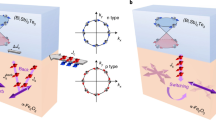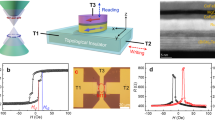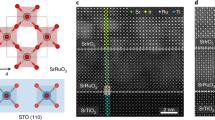Abstract
Magnetic devices are a leading contender for the implementation of memory and logic technologies that are non-volatile, that can scale to high density and high speed, and that do not wear out. However, widespread application of magnetic memory and logic devices will require the development of efficient mechanisms for reorienting their magnetization using the least possible current and power1. There has been considerable recent progress in this effort; in particular, it has been discovered that spin–orbit interactions in heavy-metal/ferromagnet bilayers can produce strong current-driven torques on the magnetic layer2,3,4,5,6,7,8,9,10,11, via the spin Hall effect12,13 in the heavy metal or the Rashba–Edelstein effect14,15 in the ferromagnet. In the search for materials to provide even more efficient spin–orbit-induced torques, some proposals16,17,18,19 have suggested topological insulators20,21, which possess a surface state in which the effects of spin–orbit coupling are maximal in the sense that an electron’s spin orientation is fixed relative to its propagation direction. Here we report experiments showing that charge current flowing in-plane in a thin film of the topological insulator bismuth selenide (Bi2Se3) at room temperature can indeed exert a strong spin-transfer torque on an adjacent ferromagnetic permalloy (Ni81Fe19) thin film, with a direction consistent with that expected from the topological surface state. We find that the strength of the torque per unit charge current density in Bi2Se3 is greater than for any source of spin-transfer torque measured so far, even for non-ideal topological insulator films in which the surface states coexist with bulk conduction. Our data suggest that topological insulators could enable very efficient electrical manipulation of magnetic materials at room temperature, for memory and logic applications.
This is a preview of subscription content, access via your institution
Access options
Subscribe to this journal
Receive 51 print issues and online access
$199.00 per year
only $3.90 per issue
Buy this article
- Purchase on Springer Link
- Instant access to full article PDF
Prices may be subject to local taxes which are calculated during checkout


Similar content being viewed by others
References
Katine, J. A. & Fullerton, E. E. Device implications of spin transfer torques. J. Magn. Magn. Mater. 320, 1217–1226 (2008)
Ando, K. et al. Electric manipulation of spin relaxation using the spin Hall effect. Phys. Rev. Lett. 101, 036601 (2008)
Pi, U. H. et al. Tilting of the spin orientation induced by Rashba effect in ferromagnetic metal layer. Appl. Phys. Lett. 97, 162507 (2010)
Liu, L. Q., Moriyama, T., Ralph, D. C. & Buhrman, R. A. Spin-torque ferromagnetic resonance induced by the spin Hall effect. Phys. Rev. Lett. 106, 036601 (2011)
Miron, I. M. et al. Perpendicular switching of a single ferromagnetic layer induced by in-plane current injection. Nature 476, 189–193 (2011)
Liu, L. Q. et al. Spin torque switching with the giant spin Hall effect of tantalum. Science 336, 555–558 (2012)
Kim, J. et al. Layer thickness dependence of the current-induced effective field vector in Ta|CoFeB|MgO. Nature Mater. 12, 240–245 (2013)
Fan, X. et al. Observation of the nonlocal spin-orbital effective field. Nature Commun. 4, 1799 (2013)
Garello, K. et al. Symmetry and magnitude of spin-orbit torques in ferromagnetic heterostructures. Nature Nanotechnol. 8, 587–593 (2013)
Emori, S., Bauer, U., Ahn, S.-M., Martinez, E. & Beach, G. S. D. Current-driven dynamics of chiral ferromagnetic domain walls. Nature Mater. 12, 611–616 (2013)
Ryu, K.-S., Thomas, L., Yang, S.-H. & Parkin, S. S. P. Chiral spin torque at magnetic domain walls. Nature Nanotechnol. 8, 527–533 (2013)
Dyakonov, M. I. & Perel, V. I. Current-induced spin orientation of electrons in semiconductors. Phys. Lett. A 35, 459–460 (1971)
Hirsch, J. E. Spin Hall effect. Phys. Rev. Lett. 83, 1834–1837 (1999)
Edelstein, V. M. Spin polarization of conduction electrons induced by electric current in two-dimensional asymmetric electron systems. Solid State Commun. 73, 233–235 (1990)
Chernyshov, A. et al. Evidence for reversible control of magnetization in a ferromagnetic material by means of spin–orbit magnetic field. Nature Phys. 5, 656–659 (2009)
Burkov, A. A. & Hawthorn, D. G. Spin and charge transport on the surface of a topological insulator. Phys. Rev. Lett. 105, 066802 (2010)
Culcer, D., Hwang, E. H., Stanescu, T. D. & Das Sarma, S. Two-dimensional surface charge transport in topological insulators. Phys. Rev. B 82, 155457 (2010)
Pesin, D. & MacDonald, A. H. Spintronics and pseudospintronics in graphene and topological insulators. Nature Mater. 11, 409–416 (2012)
Fischer, M. H., Vaezi, A., Manchon, A. & Kim, E.-A. Large spin torque in topological insulator/ferromagnetic metal bilayers. Preprint at http://arxiv.org/abs/1305.1328 (2013)
Fu, L., Kane, C. L. & Mele, E. J. Topological insulators in three dimensions. Phys. Rev. Lett. 98, 106803 (2007)
Hasan, M. Z. & Kane, C. L. Topological insulators. Rev. Mod. Phys. 82, 3045–3067 (2010)
Tanaka, T. et al. Intrinsic spin Hall effect and orbital Hall effect in 4d and 5d transition metals. Phys. Rev. B 77, 165117 (2008)
Niimi, Y. et al. Giant spin Hall effect Induced by skew scattering from bismuth impurities inside thin film CuBi alloys. Phys. Rev. Lett. 109, 156602 (2012)
Pai, C.-F. et al. Spin transfer torque devices utilizing the giant spin Hall effect of tungsten. Appl. Phys. Lett. 101, 122404 (2012)
Yazyev, O. V., Moore, J. E. & Louie, S. G. Spin polarization and transport of surface states in the topological insulators Bi2Se3 and Bi2Te3 from first principles. Phys. Rev. Lett. 105, 266806 (2010)
Bahramy, M. S. et al. Emergent quantum confinement at topological insulator surfaces. Nature Commun. 3, 1159 (2012)
Wray, L. A. et al. A topological insulator surface under strong Coulomb, magnetic and disorder perturbations. Nature Phys. 7, 32–37 (2011)
Valla, T., Pan, Z.-H., Gardner, D., Lee, Y. S. & Chu, S. Photoemission spectroscopy of magnetic and nonmagnetic impurities on the surface of the Bi2Se3 topological insulator. Phys. Rev. Lett. 108, 117601 (2012)
Heinrich, B. et al. Spin pumping at the magnetic insulator (YIG)/normal metal (Au) interfaces. Phys. Rev. Lett. 107, 066604 (2011)
Fan, Y. et al. Magnetization switching through giant spin-orbit torque in a magnetically doped topological insulator heterostructure. Nature Mater. 13, 699–704 (2014)
Slonczewski, J. C. Current-driven excitation of magnetic multilayers. J. Magn. Magn. Mater. 159, L1–L7 (1996)
King, P. D. C. et al. Large tunable Rashba spin splitting of a two-dimensional electron gas in Bi2Se3 . Phys. Rev. Lett. 107, 096802 (2011)
Manchon, A. & Zhang, S. Theory of nonequilibrium intrinsic spin torque in a single nanomagnet. Phys. Rev. B 78, 212405 (2008)
Pesin, D. A. & MacDonald, A. H. Quantum kinetic theory of current-induced torques in Rashba ferromagnets. Phys. Rev. B 86, 014416 (2012)
Manchon, A., Matsumoto, R., Jaffres, H. & Grollier, J. Spin transfer torque with spin diffusion in magnetic tunnel junctions. Phys. Rev. B 86, 060404 (2012)
Bass, J. & Pratt, W. P. Spin-diffusion lengths in metals and alloys, and spin-flipping at metal/metal interfaces: an experimentalist’s critical review. J. Phys. Condens. Matter 19, 183201 (2007)
Tserkovnyak, Y., Brataas, A. & Bauer, G. E. W. Spin pumping and magnetization dynamics in metallic multilayers. Phys. Rev. B 66, 224403 (2002)
Tserkovnyak, Y., Brataas, A., Bauer, G. E. W. & Halperin, B. I. Nonlocal magnetization dynamics in ferromagnetic heterostructures. Rev. Mod. Phys. 77, 1375–1421 (2005)
Mosendz, O. et al. Detection and quantification of inverse spin Hall effect from spin pumping in permalloy/normal metal bilayers. Phys. Rev. B 82, 214403 (2010)
Garate, I. & Franz, M. Inverse spin-galvanic effect in the interface between a topological insulator and a ferromagnet. Phys. Rev. Lett. 104, 146802 (2010)
Yokoyama, T., Zang, J. & Nagaosa, N. Theoretical study of the dynamics of magnetization on the topological surface. Phys. Rev. B 81, 241410(R) (2011)
Yokoyama, T. Current-induced magnetization reversal on the surface of a topological insulator. Phys. Rev. B 84, 113407 (2011)
Tserkovnyak, Y. & Loss, D. Thin-film magnetization dynamics on the surface of a topological insulator. Phys. Rev. Lett. 108, 187201 (2012)
Mahfouzi, F., Nagaosa, N. & Nikolic, B. K. Spin-orbit coupling induced spin-transfer torque and current polarization in topological-insulator/ferromagnet vertical heterostructures. Phys. Rev. Lett. 109, 166602 (2012)
Acknowledgements
We thank R. Buhrman, C.-F. Pai, N. Reynolds, J. Gibbons, A. Alemi and M. Bierbaum for discussions and assistance with experiments. Work at Cornell and Penn State was supported by DARPA (N66001-11-1-4110). We acknowledge additional funding for work at Cornell from the NSF/MRSEC-funded Cornell Center for Materials Research (DMR-1120296), the Army Research Office (W911NF-08-2-0032) and the NSF (DMR-1010768), and for work at Penn State from the Office of Naval Research (N00014-12-1-0117). A.R.M. acknowledges a DOE Office of Science graduate fellowship and J.L.G. acknowledges an NSF graduate fellowship. J.S.L. and N.S. acknowledge partial support through C-SPIN, one of six centres of STARnet, a Semiconductor Research Corporation program, sponsored by MARCO and DARPA. This work was performed in part at the Cornell NanoScale Facility and the Penn State Nanofabrication Facility, both nodes of the National Nanotechnology Infrastructure Network (NNIN), which is supported by the NSF (ECS-0335765), and in the facilities of the Cornell Center for Materials Research.
Author information
Authors and Affiliations
Contributions
A.R.M., J.S.L., A.R., N.S. and D.C.R. had the idea for and designed the experiments. A.R.M., J.L.G. and P.J.M. performed the sample fabrication, measurements and analysis. J.S.L., A.R. and N.S. developed the growth process for the Bi2Se3 layers. M.H.F., A.V., A.M. and E.-A.K. performed theoretical modelling. N.S. and D.C.R. provided oversight and advice. A.R.M. and D.C.R. wrote the manuscript and all authors contributed to its final version.
Corresponding author
Ethics declarations
Competing interests
The authors declare no competing financial interests.
Extended data figures and tables
Extended Data Figure 1 Change in resonant field as a function of direct current.
The data correspond to an 8 nm Bi2Se3/16 nm permalloy device with dimensions 50 μm × 15 μm, averaged over frequencies between 6 and 10 GHz. Error bars, 1 s.d.
Extended Data Figure 2 Measured linewidth versus frequency.
The data correspond to an 8 nm Bi2Se3/16 nm permalloy device with dimensions 50 μm × 10 μm at different direct currents. Error bars, 1 s.d.
Extended Data Figure 3 Control experiments.
a, A comparison between the ST-FMR signals measured for two 50 μm × 15 μm devices at 8 GHz, one with 8 nm Bi2Se3/16 nm permalloy and the other a single layer of 16 nm permalloy. The absorbed radio-frequency power was 5 dBm and ϕ = 45° in both cases. b, ST-FMR measurement for a 6 nm Pt/16 nm permalloy device with dimensions 80 μm × 24 μm. The absorbed power was 5 dBm and ϕ = 45°.
Extended Data Figure 5 The predicted value of the out-of-plane spin torque ratio relative to the in-plane spin torque ratio.
 as a function of
as a function of  , for
, for  = 5 nm.
= 5 nm.
Extended Data Figure 6 Anisotropic magnetoresistance calibration.
The data correspond to an 8 nm Bi2Se3/16 nm permalloy device with dimensions 50 μm × 15 μm, and were measured at room temperature.
PowerPoint slides
Rights and permissions
About this article
Cite this article
Mellnik, A., Lee, J., Richardella, A. et al. Spin-transfer torque generated by a topological insulator. Nature 511, 449–451 (2014). https://doi.org/10.1038/nature13534
Received:
Accepted:
Published:
Issue Date:
DOI: https://doi.org/10.1038/nature13534
This article is cited by
-
Spin-resolved topology and partial axion angles in three-dimensional insulators
Nature Communications (2024)
-
Room temperature nonlocal detection of charge-spin interconversion in a topological insulator
npj 2D Materials and Applications (2024)
-
Field-free switching of perpendicular magnetization by two-dimensional PtTe2/WTe2 van der Waals heterostructures with high spin Hall conductivity
Nature Materials (2024)
-
Electrical switching of the edge current chirality in quantum anomalous Hall insulators
Nature Materials (2024)
-
Magneto-strain effects in 2D ferromagnetic van der Waal material CrGeTe\(_3\)
Scientific Reports (2023)
Comments
By submitting a comment you agree to abide by our Terms and Community Guidelines. If you find something abusive or that does not comply with our terms or guidelines please flag it as inappropriate.



